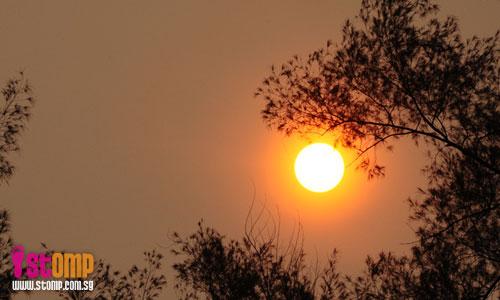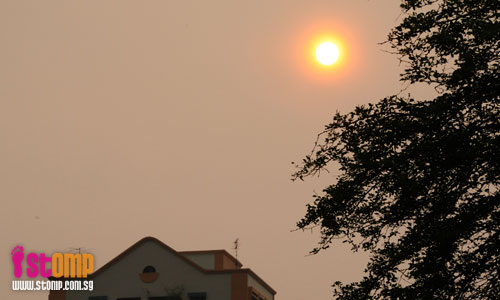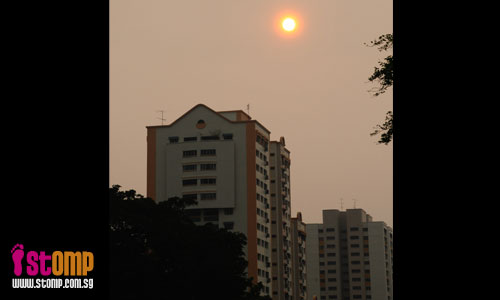
STOMPer Alan captured these photos of what seemed to be a reddish-looking sun from his home in Joo Seng Road at about 8.30am yesterday (Feb 17).
Could the recent bush-fires and haze be the cause of this, he wonders.
He says:
"The recent haze and bush-fires may have caused the sun to turn dark red in the morning and also carries an halo.
"It is a phenomenon you don't see often."



Go here for relevant news articles and related Seen on STOMP posts on bushfires in Singapore
The person who submitted this article is correct in guessing that the haze and smoke from the bushfires is causing this effect.
What we are seeing is a phenomenon known as Rayleigh scattering. In essence, as it travels through the atmosphere, the sun's light is scattered due to the presence of tiny particles in the air. Blue light, which has a shorter wavelength than red light, is scattered much more easily; this is why the sky appears blue during the day, and also explains why the sun takes on a more reddish tinge during sunrise and sunset.
WikiAnswers explains it in layman terms:
White light coming from the Sun contains all colors of light from red to blue. The molecules in Earth's atmosphere do not scatter much of the red light, but they do scatter a significant amount of blue light. This effect causes the blue sky.
These molecules scattering light also cause the Sun to appear redder than it really is. When the Sun is high in the sky the amount of reddening is small. However the Sun will still appear redder from the ground than from space because the atmosphere scatters some of the blue light.
When the Sun is low in the sky, much more of the blue light coming from the Sun is scattered away from the direct path towards our eyes. Hence the Sun will appear very red when it is low in the sky.
[...]
The effect can increase when the Sun sets or rises over a large city. Pollution particles increase the effect by scattering or absorbing more blue light than red light.
Due to the increased amount of particles in the air due to the smoke from bushfires, there is increased scattering of blue light, hence accounting for the sun's reddish tinge. Similarly, volcanic eruptions that throw up lots of dust and ash into the atmosphere can also cause spectacularly red sunsets.
I haven't really paid any attention to the sunrise and sunset lately, but if the sun does indeed look like this in the mornings and evenings, this is the most plausible explanation.
Red Sun, Red Moon
They said someday you'll find
All who love are blind
Oh, when your heart's on fire
You must realise
Smoke gets in your eyes
- Smoke Gets In Your Eyes by The Platters